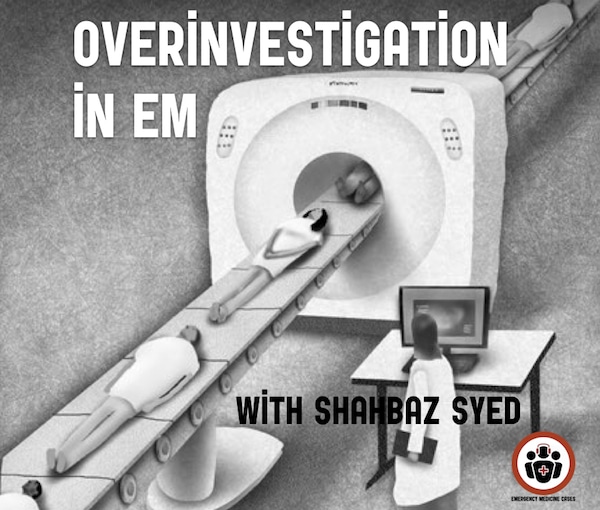With increased access to timely advanced diagnostic testing in EDs rational resource utilization is becoming ever more important. In his Best Case Ever Dr. Shahbaz Syed argues that a patient at Janus General who presented to the ED with chest pain, died as a result of overinvestigation, and explains how understanding the factors that contribute to overinvestigation, Baysian theory, diagnostic decision analysis, radiation risk, and teaching “dogma” may help prevent overinvestigation in Emergency Medicine…
Podcast production and sound design by Rajiv Thavanathan and Richard Hoang
Blog post by Anton Helman, June, 2018
Factors that contribute to Overinvestigation in Emergency Medicine
Diagnostic uncertainty, low risk tolerance, fear of missing a diagnosis, financial and hospital administration incentives to order tests, a trend toward increasing patient expectations and society’s decreasing tolerance for risk in general, all contribute to overinvestigation in EM. Despite this ever-increasing trend, there is little, if any, evidence that increased diagnostic testing improves patient outcomes (even though it might make us feel better at the time). Every time we order tests it is imperative that we consider the pre-test probability, the true seriousness of missing the diagnosis and the downsides of a false positive or false negative.
“In EM we’ve started to use tests almost as a surrogate for good doctoring.”
The 4 Principles of diagnostic decision analysis
(adapted from the landmark paper ‘Pathways through uncertainty’)
- Patients do not have disease, only a probability of disease.
- Diagnostic tests merely help revise probabilities.
- Test interpretation should precede test ordering.
- If the revisions in probabilities caused by a diagnostic test do not entail a change in subsequent management, use of the test should be reconsidered.
Use the concept of test threshold to guide work-ups
The Test Threshold is the probability of disease below which or above which there would be no further testing that would be considered necessary for that circumstance. Tests do not give you a binary answer; rather, they change probabilities to a small or large degree until you reach a test threshold to trigger the clinician to act or not act.
Great explanation of Baysian Theory
Shared Decision Making requires taking into consideration the patient’s risk tolerance. It is important to realize that, in general, patients underestimate the risk of investigations and interventions and overestimate the benefit of action.
XrayRisk has a radiation exposure calculator to aid in shared decision making around imaging.
How to prevent Overinvestigation in Emergency Medicine
Rather than overinvestigating, we need to be confident in some situations that with good history taking, physical examination, bedside tests and clear discharge instructions, our patients will be safe and well cared for. Taking a few minutes to educated patients about their condition, participate in shared decision making and explain good discharge instructions (rather than simply ordering a CT scan), may improve patient flow, save time, radiation exposure and cost.
Next time you are considering whether or not to order a test, ask yourself “I am doing this for the benefit of my patients or to make myself feel better?” We need to be comfortable with uncertainty in EM – it’s a key element of a successful career.
References
Moynihan R, Doust J, Henry D. Preventing overdiagnosis: how to stop harming the healthy. BMJ. 2012;344:e3502.
Schechter MT, Sheps SB. Diagnostic testing revisited: pathways through uncertainty. Can Med Assoc J. 1985;132(7):755-60.
Pines J, Szyld D. Risk tolerance for the exclusion of potentially life-threatening diseases in the ED. Am J Emerg Med. 2007;25(5):540-544.
Flynn D, Knoedler M, Hess E, et al. Engaging patients in health care decisions in the emergency department through shared decision-making: a systematic review. Acad Emerg Med. 2012;19(8):959-967.
Greenberg J, Green J. Over-testing: why more is not better. Am J Med. 2014;127(5):362-363.
Other FOAMed Resources on Overinvestigation in the ED
Dr. Syed explains Resource Utilization on CanadiEM
Dr. Syed explains Shared Decision Making on CanadiEM
Diagnostic decision making in EM on EM Cases with Chris Hicks, Walter Himmel and David Dushenski





I agree with some but also comes satisfaction for the patient and for the treating physian…. Take for an example silent MI???
Many diseases that were accedently found during some ruteine investigation (hospital protocols may differ from place to place… but he did hit a very important topic… thank you